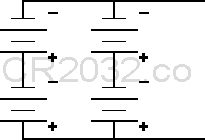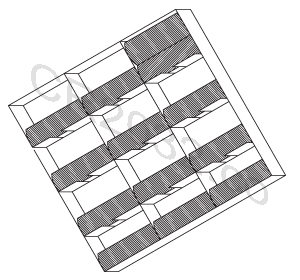Series, Parallel, and Series-Parallel Circuit Configurations
Designing a circuit that uses batteries will often involve a critical decision between using a series or parallel circuit. This brief article highlights some of the pros and cons of working with each configuration, as well as some other helpful tips and general information about series and parallel circuits.
Series Circuits
In general, series configurations are used to achieve a higher voltage. For example, if a circuit requires 6 volts, two 3 volt CR2032 batteries could be connected in series to provide the needed voltage. However, the capacity of the circuit remains the same, so if each CR2032 has a capacity of 225 mAh, the our total circuit would still only have 225 mAh. With series circuits, a defective battery in the series can cause the voltage to be lower than needed- which would likely lead to an equipment failure, among other possibilities.

Parallel Circuits
Parallel configurations are usually used to achieve a higher capacity. For example, if a circuit requires 1.2 volts and a higher capacity, two 1.2 volt NiCD batteries could be connected in parallel to give the needed 1.2 volts, but with twice the capacity offered by each individual battery. A defective battery in a parallel circuit can cause a low runtime, but without affecting the voltage, however there is a potential fire hazard when one cell in a parallel circuit shorts.

Series-Parallel Circuits
Series-parallel configurations are a combination of the above two designs. It is best to think of a series-parallel circuit as a parallel circuit, in which the parallel cells are actually series circuits. A very common usage of parallel-series circuits is with lithium batteries, for example 18650 rechargeable lithium-ion batteries. So, if four 18650 batteries were connected in a series-parallel circuit, that would really be a parallel circuit of two series circuits of two 18650 batteries. If each lithium-ion 18650 battery has a voltage of 3.7 volts, and a capacity of 2600 mAh, that would mean that each of the two series circuits has a voltage of 7.4 volts and a current of 2600 mAh. Our parallel circuit is therefore acting as if it has two batteries with 7.4 volts and 2600 mAh, thus giving our series-parallel a total of 7.4 volts and 5200 mAh. Series-parallel circuits are robust in having the strengths of both a series and parallel circuit, however it should also be taken into consideriation that they have both of the weaknesses as well. A faulty cell will count for both a failure in a series circuit as well as in the overall parallel circuit.

Battery Holders and Circuit Configurations
Battery holders should be selected based on the circuit you have chosen ahead of time. A good battery holder manufacturer will be able to provide holders for the configuration that your product requires, whether you want two CR2032 batteries in a series, two AAA batteries in parallel, or four AA batteries in a series-parallel circuit. For general information about battery holders, please visit batteryholders.org, or check out these battery holder tips

Return
Series Circuits
In general, series configurations are used to achieve a higher voltage. For example, if a circuit requires 6 volts, two 3 volt CR2032 batteries could be connected in series to provide the needed voltage. However, the capacity of the circuit remains the same, so if each CR2032 has a capacity of 225 mAh, the our total circuit would still only have 225 mAh. With series circuits, a defective battery in the series can cause the voltage to be lower than needed- which would likely lead to an equipment failure, among other possibilities.

Parallel Circuits
Parallel configurations are usually used to achieve a higher capacity. For example, if a circuit requires 1.2 volts and a higher capacity, two 1.2 volt NiCD batteries could be connected in parallel to give the needed 1.2 volts, but with twice the capacity offered by each individual battery. A defective battery in a parallel circuit can cause a low runtime, but without affecting the voltage, however there is a potential fire hazard when one cell in a parallel circuit shorts.

Series-Parallel Circuits
Series-parallel configurations are a combination of the above two designs. It is best to think of a series-parallel circuit as a parallel circuit, in which the parallel cells are actually series circuits. A very common usage of parallel-series circuits is with lithium batteries, for example 18650 rechargeable lithium-ion batteries. So, if four 18650 batteries were connected in a series-parallel circuit, that would really be a parallel circuit of two series circuits of two 18650 batteries. If each lithium-ion 18650 battery has a voltage of 3.7 volts, and a capacity of 2600 mAh, that would mean that each of the two series circuits has a voltage of 7.4 volts and a current of 2600 mAh. Our parallel circuit is therefore acting as if it has two batteries with 7.4 volts and 2600 mAh, thus giving our series-parallel a total of 7.4 volts and 5200 mAh. Series-parallel circuits are robust in having the strengths of both a series and parallel circuit, however it should also be taken into consideriation that they have both of the weaknesses as well. A faulty cell will count for both a failure in a series circuit as well as in the overall parallel circuit.

Battery Holders and Circuit Configurations
Battery holders should be selected based on the circuit you have chosen ahead of time. A good battery holder manufacturer will be able to provide holders for the configuration that your product requires, whether you want two CR2032 batteries in a series, two AAA batteries in parallel, or four AA batteries in a series-parallel circuit. For general information about battery holders, please visit batteryholders.org, or check out these battery holder tips

